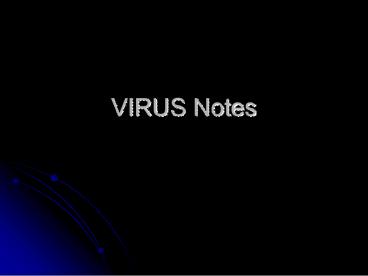VIRUS Notes - PowerPoint PPT Presentation
1 / 18
Title:
VIRUS Notes
Description:
VIRUS Notes Definition Viruses are tiny particles unlike any other organism. A virus consists of genetic material such as RNA or DNA wrapped in a protein coat. – PowerPoint PPT presentation
Number of Views:82
Avg rating:3.0/5.0
Title: VIRUS Notes
1
VIRUS Notes
2
Definition
- Viruses are tiny particles unlike any other
organism. A virus consists of genetic material
such as RNA or DNA wrapped in a protein coat.
3
Characteristics of Life
- Homeostasis
- Nutrition
- Transport
- Respiration
- Synthesis
- Growth
- Excretion
- Regulation
- Reproduction
- Is a virus living?
4
Is it living?
- No, because a virus can not reproduce on its own.
It needs a host cells.
5
How does a virus size relate to the size of the
cell?
- Viruses are much smaller than a cell and that is
why they can easily get into a cell
6
How are viruses characterized?
- Characterized as
- Plant
- Animal
- Bacterial virus
7
What are the two parts that comprise a virus?
- Nucleic Acid Core (either RNA or DNA)
- Protein Coat called a capsid
8
Shapes of Viruses
- 1. Rod shaped (tobacco mosaic virus)
9
Shapes of Virus
- 2. Polyhedral (Mumps)
10
Shapes of Virus
- 3. Helical (Herpes)
11
How does a DNA virus replicate?
- DNA virus produces RNA (transciption)
- RNA directs production of viral proteins
- OR
- Viral DNA combines with host cells DNA (either
plant or animal)
12
How does RNA virus replicate or reproduce itself?
- Once inside the host, an RNA virus directs the
host cell to produce proteins - OR
- Viral RNA may make DNA
13
Retrovirus
- Virus that has RNA as its genetic material
- Example is HIV
14
Bacteriophage
- Virus that attacks a bacterial cell
- Two types of infection
- Lytic Cycle
- Lysogenic Cycle
15
Lytic Cycle
- Bacteriophage attaches to host cell and injects
its DNA - Foreign DNA produces more proteins in the host
cell - Causes cell to lyse (or break open) and the
virus/phage is released into the hosts body
16
Lytic Cycle
17
Lysogenic Cycle
- Phage injects DNA into the host cell
- Foreign/phage DNA integrates itself into a
chromosome - Bacteria reproduces
18
Lytic vs.Lysogenic Cycle































